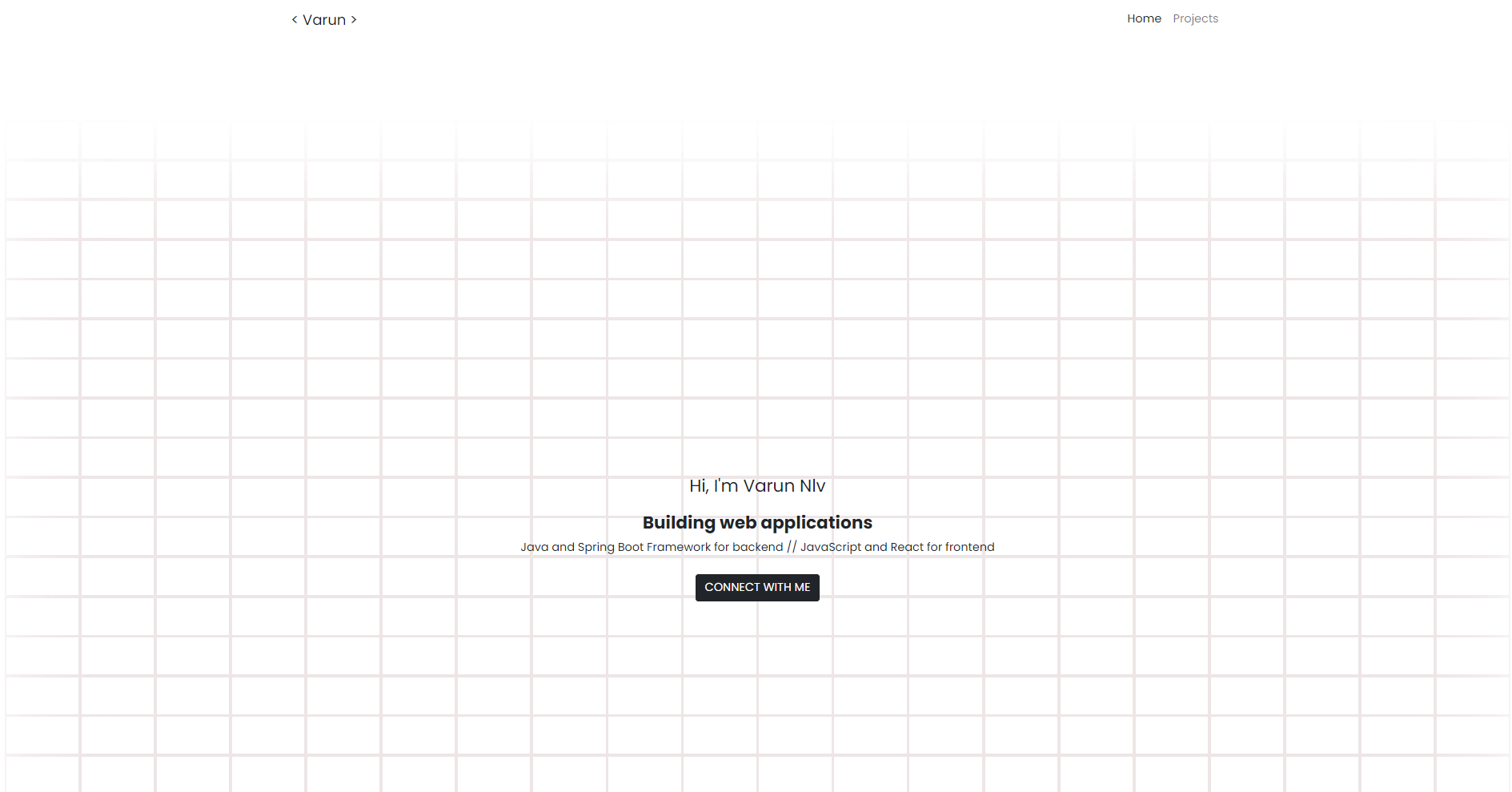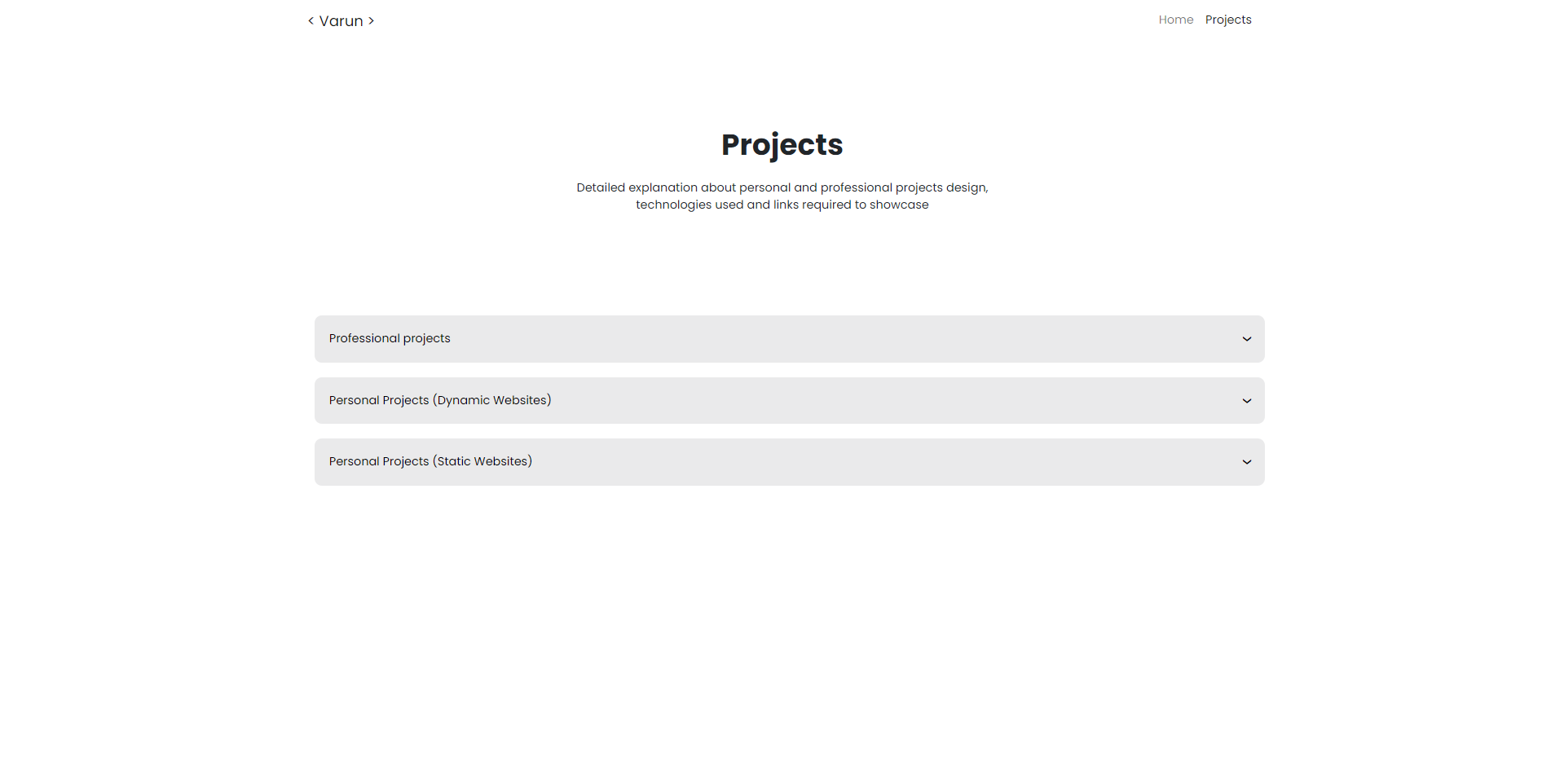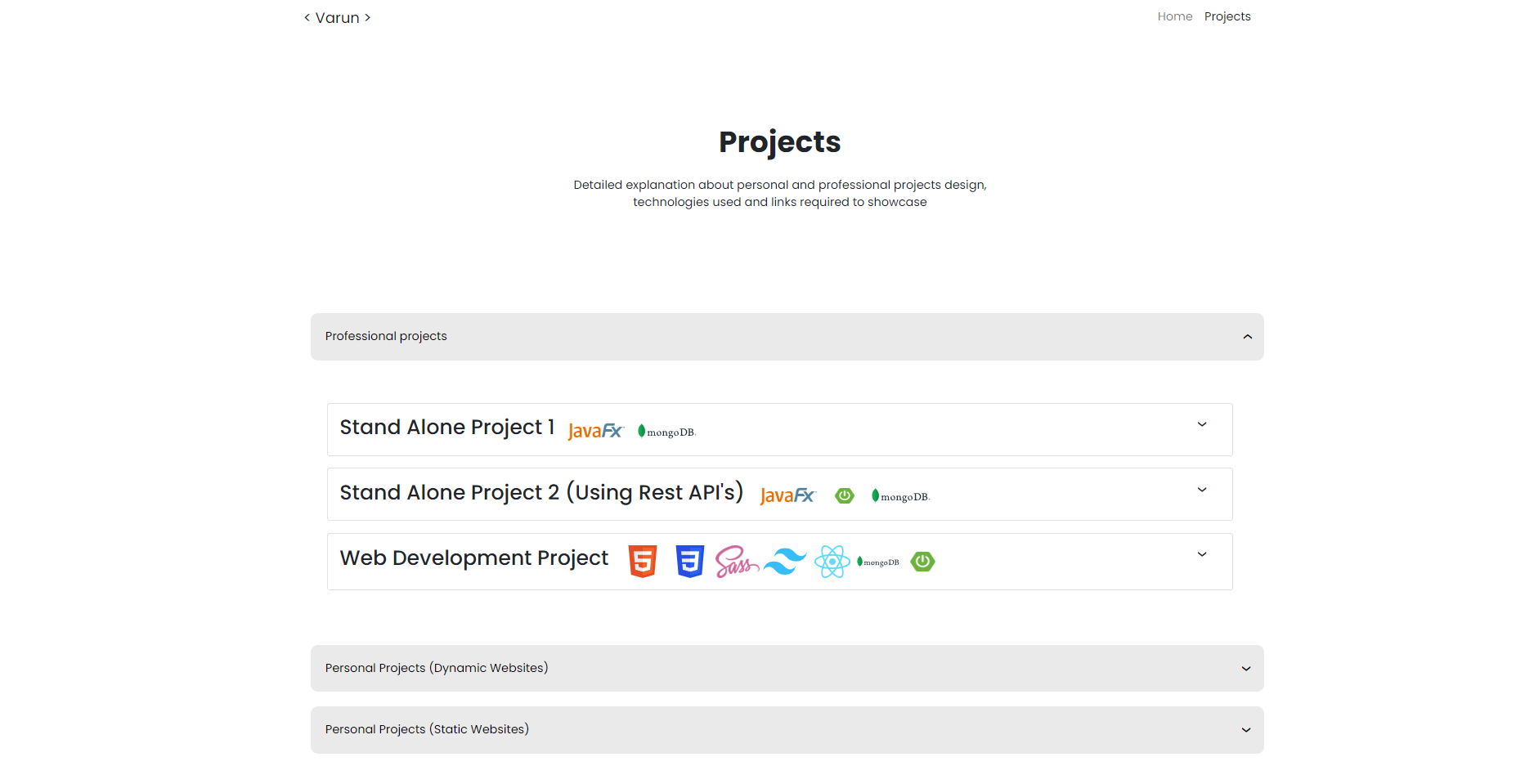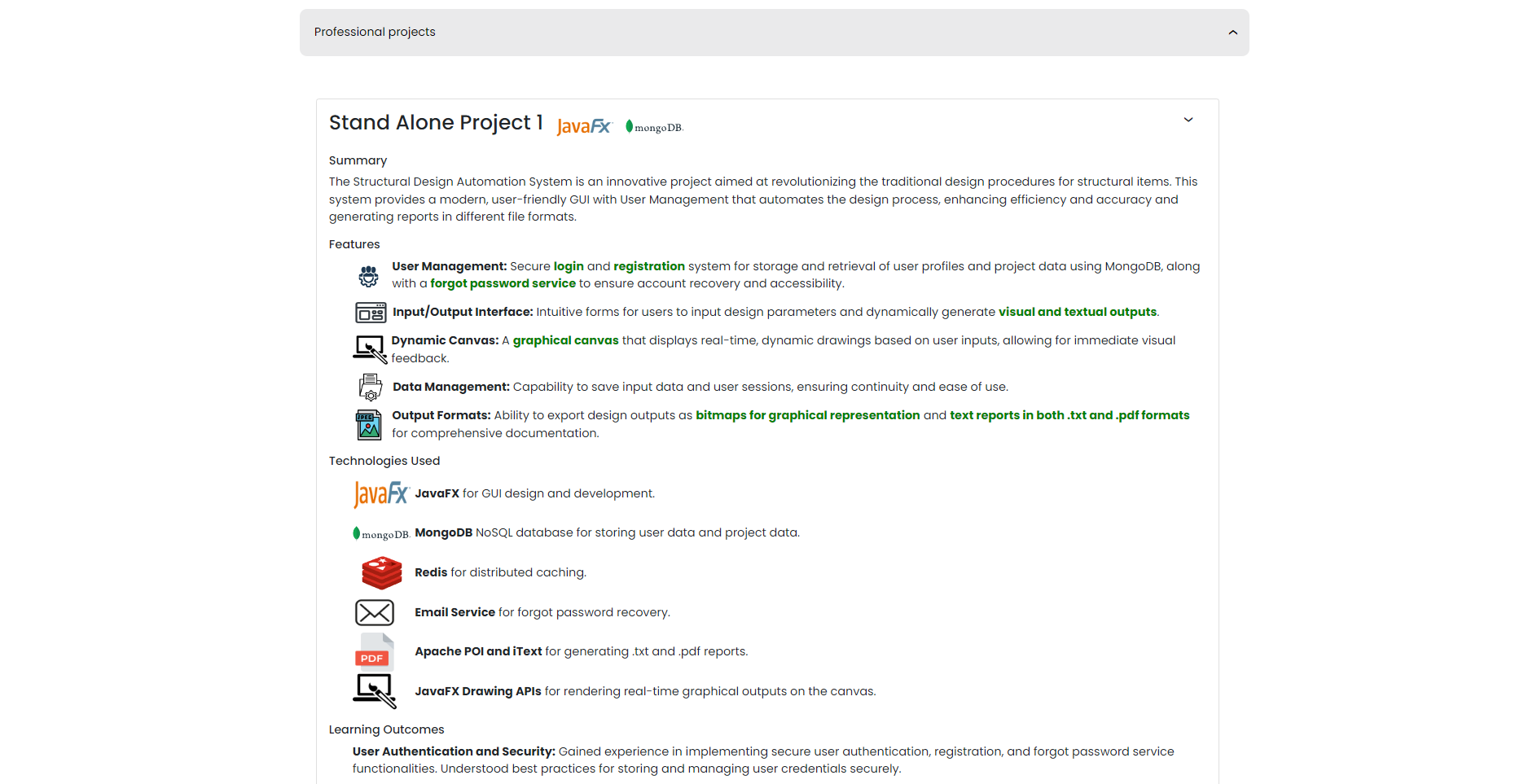Projects
Detailed explanation about personal and professional projects design, technologies used and links required to showcase
Stand Alone Project 1

Summary
The Structural Design Automation System is an innovative project aimed at revolutionizing the traditional design procedures for structural items. This system provides a modern, user-friendly GUI with User Management that automates the design process, enhancing efficiency and accuracy and generating reports in different file formats.
Features
-
 User Management: Secure login and registration system for storage and retrieval of user profiles and project data using MongoDB, along with a forgot password service to ensure account recovery and accessibility.
User Management: Secure login and registration system for storage and retrieval of user profiles and project data using MongoDB, along with a forgot password service to ensure account recovery and accessibility. -
 Input/Output Interface: Intuitive forms for users to input design parameters and dynamically generate visual and textual outputs.
Input/Output Interface: Intuitive forms for users to input design parameters and dynamically generate visual and textual outputs. -
 Dynamic Canvas: A graphical canvas that displays real-time, dynamic drawings based on user inputs, allowing for immediate visual feedback.
Dynamic Canvas: A graphical canvas that displays real-time, dynamic drawings based on user inputs, allowing for immediate visual feedback. -
 Data Management: Capability to save input data and user sessions, ensuring continuity and ease of use.
Data Management: Capability to save input data and user sessions, ensuring continuity and ease of use. -
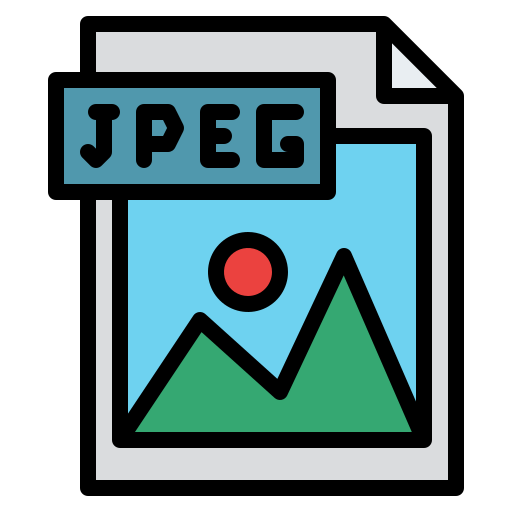 Output Formats: Ability to export design outputs as bitmaps for graphical representation and text reports in both .txt and .pdf formats for comprehensive documentation.
Output Formats: Ability to export design outputs as bitmaps for graphical representation and text reports in both .txt and .pdf formats for comprehensive documentation.
Technologies Used
-
 JavaFX for GUI design and development.
JavaFX for GUI design and development. -
MongoDB NoSQL database for storing user data and project data.
-
Redis for distributed caching.
-
 Email Service for forgot password recovery.
Email Service for forgot password recovery. -
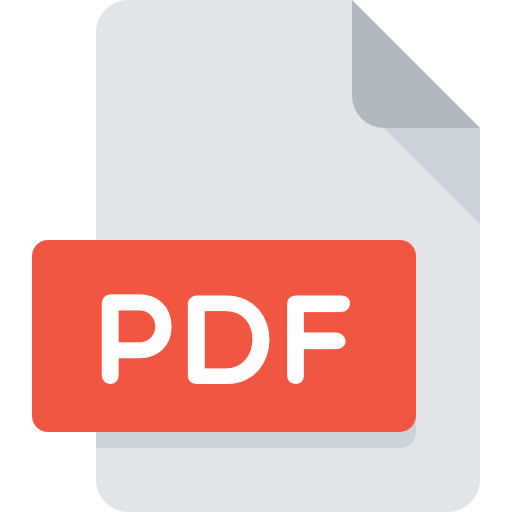 Apache POI and iText for generating .txt and .pdf reports.
Apache POI and iText for generating .txt and .pdf reports. -
 JavaFX Drawing APIs for rendering real-time graphical outputs on the canvas.
JavaFX Drawing APIs for rendering real-time graphical outputs on the canvas.
Learning Outcomes
-
User Authentication and Security: Gained experience in implementing secure user authentication, registration, and forgot password service functionalities. Understood best practices for storing and managing user credentials securely.
-
OOP with Singleton Design Pattern: Applied object-oriented programming principles using the Singleton design pattern.
-
Database Management: Designed and implemented a schema for user and project data in MongoDB. Performed CRUD operations and handled data persistence.
-
Graphical User Interface (GUI) Development: Designed intuitive and user-friendly forms for data input using JavaFX. Implemented dynamic UI elements that respond to user input in real-time and developed a graphical canvas for real-time drawings and visual feedback.
-
File Export and Report Generation: Exported graphical outputs as bitmap images and generated comprehensive textual reports in .txt and .pdf formats using libraries like Apache POI and iText. Provided export options in the GUI for easy user access.
-
Software Architecture: Applied the Model-View-Controller (MVC) pattern to separate concerns and improve maintainability. Implemented the Singleton and DAO patterns for efficient resource management and data access.
-
Data Binding and Real-time Updates: Implemented data binding techniques to ensure real-time updates of visual and textual outputs based on user inputs. Used JavaFX's properties and bindings to synchronize data between the model and the view.
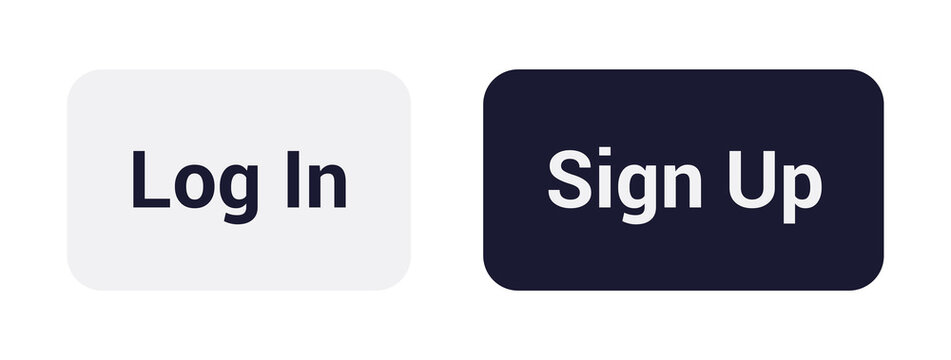
Stand Alone Project 2 (Using Rest API's)


Summary
The Structural Design Automation System is an innovative project aimed at revolutionizing the traditional design procedures for structural items. This system provides a modern, user-friendly GUI with User Management that automates the design process, enhancing efficiency and accuracy and generating reports in different file formats.
Features
-
 User Management: Secure login and registration system for storage and retrieval of user profiles and project data using MongoDB, along with a forgot password service to ensure account recovery and accessibility.
User Management: Secure login and registration system for storage and retrieval of user profiles and project data using MongoDB, along with a forgot password service to ensure account recovery and accessibility. -
 Input/Output Interface: Intuitive forms for users to input design parameters and dynamically generate visual and textual outputs.
Input/Output Interface: Intuitive forms for users to input design parameters and dynamically generate visual and textual outputs. -
 Dynamic Canvas: A graphical canvas that displays real-time, dynamic drawings based on user inputs, allowing for immediate visual feedback.
Dynamic Canvas: A graphical canvas that displays real-time, dynamic drawings based on user inputs, allowing for immediate visual feedback. -
 Data Management: Capability to save input data and user sessions, ensuring continuity and ease of use.
Data Management: Capability to save input data and user sessions, ensuring continuity and ease of use. -
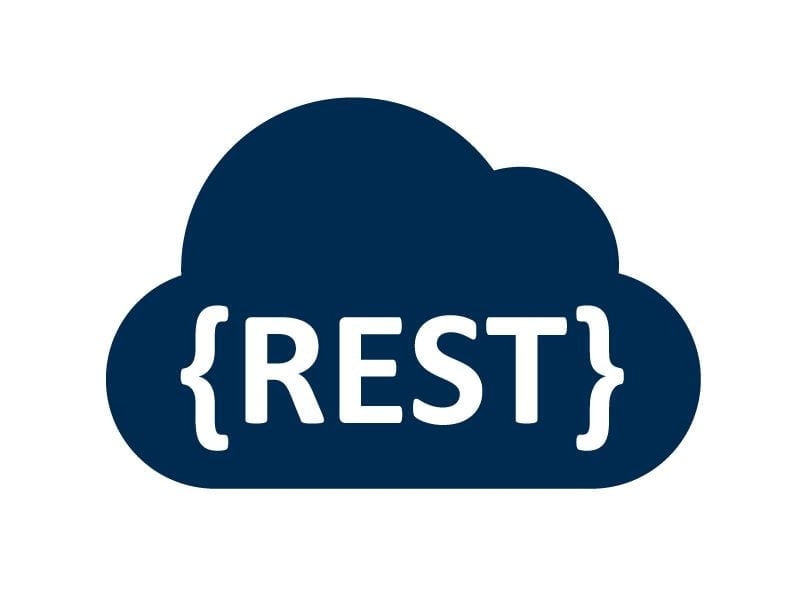 Api Management: Ability to export design outputs as bitmaps for graphical representation and text reports in both .txt and .pdf formats for comprehensive documentation.
Api Management: Ability to export design outputs as bitmaps for graphical representation and text reports in both .txt and .pdf formats for comprehensive documentation. -
 Output Formats: Ability to export design outputs as bitmaps for graphical representation and text reports in both .txt and .pdf formats for comprehensive documentation.
Output Formats: Ability to export design outputs as bitmaps for graphical representation and text reports in both .txt and .pdf formats for comprehensive documentation.
Technologies Used
-
 JavaFX for GUI design and development.
JavaFX for GUI design and development. -
MongoDB NoSQL database for storing user data and project data.
-
Redis for distributed caching.
-
 Email Service for forgot password recovery.
Email Service for forgot password recovery. -
 Apache POI and iText for generating .txt and .pdf reports.
Apache POI and iText for generating .txt and .pdf reports. -
 JavaFX Drawing APIs for rendering real-time graphical outputs on the canvas.
JavaFX Drawing APIs for rendering real-time graphical outputs on the canvas. -
 Rest Api for rendering real-time graphical outputs on the canvas.
Rest Api for rendering real-time graphical outputs on the canvas. -
 Spring Boot for rendering real-time graphical outputs on the canvas.
Spring Boot for rendering real-time graphical outputs on the canvas.
Learning Outcomes
-
User Authentication and Security: Gained experience in implementing secure user authentication, registration, and forgot password service functionalities. Understood best practices for storing and managing user credentials securely.
-
OOP with Singleton Design Pattern: Applied object-oriented programming principles using the Singleton design pattern.
-
Database Management: Designed and implemented a schema for user and project data in MongoDB. Performed CRUD operations and handled data persistence.
-
Graphical User Interface (GUI) Development: Designed intuitive and user-friendly forms for data input using JavaFX. Implemented dynamic UI elements that respond to user input in real-time and developed a graphical canvas for real-time drawings and visual feedback.
-
File Export and Report Generation: Exported graphical outputs as bitmap images and generated comprehensive textual reports in .txt and .pdf formats using libraries like Apache POI and iText. Provided export options in the GUI for easy user access.
-
Software Architecture: Applied the Model-View-Controller (MVC) pattern to separate concerns and improve maintainability. Implemented the Singleton and DAO patterns for efficient resource management and data access.
-
Microservices Communication: Exported graphical outputs as bitmap images and generated comprehensive textual reports in .txt and .pdf formats using libraries like Apache POI and iText. Provided export options in the GUI for easy user access.

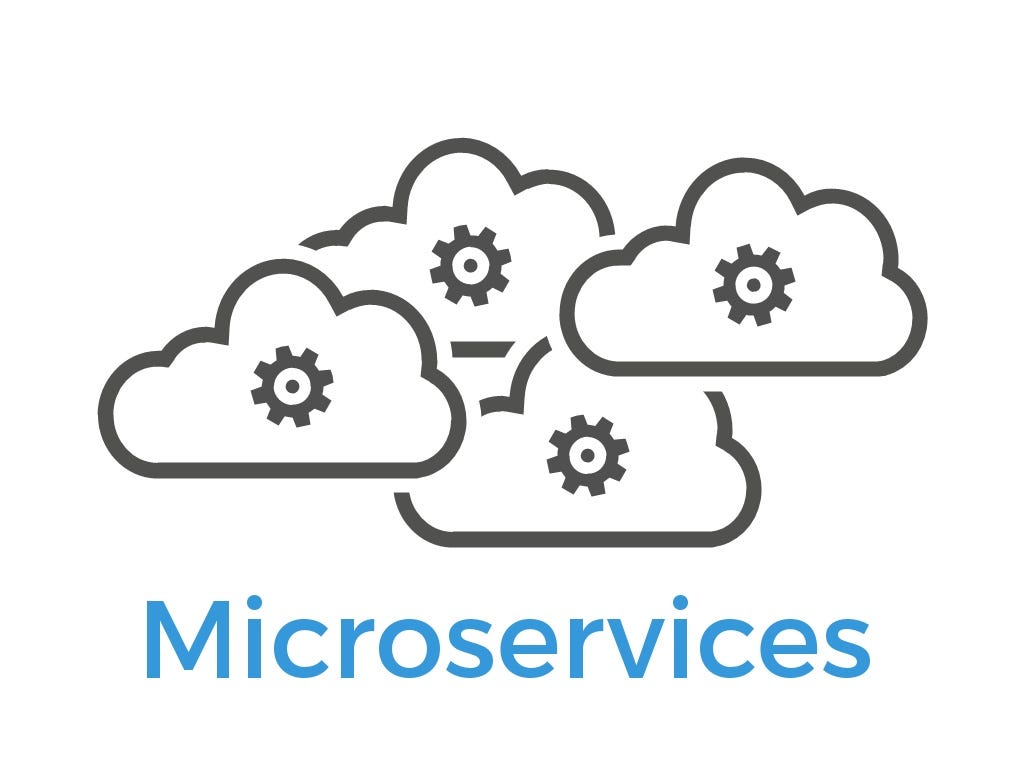
Web Development Project



 ❮
❮
❮
❮
Summary
The Structural Design Automation System is an innovative project aimed at revolutionizing the traditional design procedures for structural items. This system provides a modern, user-friendly web interface with User Management that automates the design process, enhancing efficiency and accuracy, and generating reports in different file formats.
Features
-
 User Management: Secure login and registration system for storage and retrieval of user profiles and project data using MongoDB, along with a forgot password service to ensure account recovery and accessibility.
User Management: Secure login and registration system for storage and retrieval of user profiles and project data using MongoDB, along with a forgot password service to ensure account recovery and accessibility. -
 Input/Output Interface: Intuitive forms for users to input design parameters and dynamically generate visual and textual outputs.
Input/Output Interface: Intuitive forms for users to input design parameters and dynamically generate visual and textual outputs. -
 Dynamic Canvas: A graphical canvas that displays real-time, dynamic drawings based on user inputs, allowing for immediate visual feedback.
Dynamic Canvas: A graphical canvas that displays real-time, dynamic drawings based on user inputs, allowing for immediate visual feedback. -
 Data Management: Capability to save input data and user sessions, ensuring continuity and ease of use.
Data Management: Capability to save input data and user sessions, ensuring continuity and ease of use. -
 Api Management: Ability to export design outputs as bitmaps for graphical representation and text reports in both .txt and .pdf formats for comprehensive documentation.
Api Management: Ability to export design outputs as bitmaps for graphical representation and text reports in both .txt and .pdf formats for comprehensive documentation. -
 Output Formats: Ability to export design outputs as bitmaps for graphical representation and text reports in both .txt and .pdf formats for comprehensive documentation.
Output Formats: Ability to export design outputs as bitmaps for graphical representation and text reports in both .txt and .pdf formats for comprehensive documentation.
Technologies Used
-
React for building the frontend web application.
-
MongoDB NoSQL database for storing user data and project data.
-
Redis for distributed caching.
-
 Email Service for forgot password recovery.
Email Service for forgot password recovery. -
 Apache POI and iText for generating .txt and .pdf reports.
Apache POI and iText for generating .txt and .pdf reports. -
 JavaFX Drawing APIs for rendering real-time graphical outputs on the canvas.
JavaFX Drawing APIs for rendering real-time graphical outputs on the canvas. -
 Rest Api for rendering real-time graphical outputs on the canvas.
Rest Api for rendering real-time graphical outputs on the canvas. -
 Spring Boot REST API Instead of using JDBC, a Spring Boot REST API approach is adopted for backend database connections.
Spring Boot REST API Instead of using JDBC, a Spring Boot REST API approach is adopted for backend database connections. -
HTML,CSS,SCSS,TAILWIND for frontend UI.
Learning Outcomes
-
User Authentication and Security: Gained experience in implementing secure user authentication, registration, and forgot password service functionalities. Understood best practices for storing and managing user credentials securely.
-
OOP with Singleton Design Pattern: Applied object-oriented programming principles using the Singleton design pattern.
-
Database Management: Designed and implemented a schema for user and project data in MongoDB. Performed CRUD operations and handled data persistence.
-
Graphical User Interface (GUI) Development: Designed intuitive and user-friendly forms for data input using JavaFX. Implemented dynamic UI elements that respond to user input in real-time and developed a graphical canvas for real-time drawings and visual feedback.
-
File Export and Report Generation: Exported graphical outputs as bitmap images and generated comprehensive textual reports in .txt and .pdf formats using libraries like Apache POI and iText. Provided export options in the GUI for easy user access.
-
Software Architecture: Applied the Model-View-Controller (MVC) pattern to separate concerns and improve maintainability. Implemented the Singleton and DAO patterns for efficient resource management and data access.
-
Microservices Communication: Exported graphical outputs as bitmap images and generated comprehensive textual reports in .txt and .pdf formats using libraries like Apache POI and iText. Provided export options in the GUI for easy user access.


Filmpire

 ❮
❮
❮
❮
Summary
Filmpire is a real-time movie ticket booking website designed with a robust architecture to handle high traffic and ensure seamless user experience. The platform leverages modern technologies to offer secure authentication, efficient state management, real-time seat updates, and scalable backend services.
Features
- Dynamic Card Addition: Users can add cards with custom descriptions and headings.
- Flexbox Layout: Cards are arranged using the Flexbox layout, demonstrating various Flexbox properties and behaviors.
- Responsive Design: The layout adapts to different screen sizes, ensuring a seamless user experience on all devices.
- Random Colors: Each card is assigned a random color to enhance visual variety and appeal.
Technologies Used
- HTML & CSS for structuring and styling the web pages.
- JavaScript for adding dynamic functionality, such as generating random colors and handling user input.
Learning Outcomes
- Flexbox Layout: Effectively using Flexbox properties to create a flexible and responsive layout. Gain practical experience in using Flexbox to create flexible, responsive layouts.
- Dynamic Web Development: Enhance skills in JavaScript for handling dynamic content and user interactions.
- Responsive Design Principles: Learn and apply best practices for responsive web design.
- Visual Design: Understand the impact of color in UI design and how to implement random color generation in a cohesive manner.
Screenshots
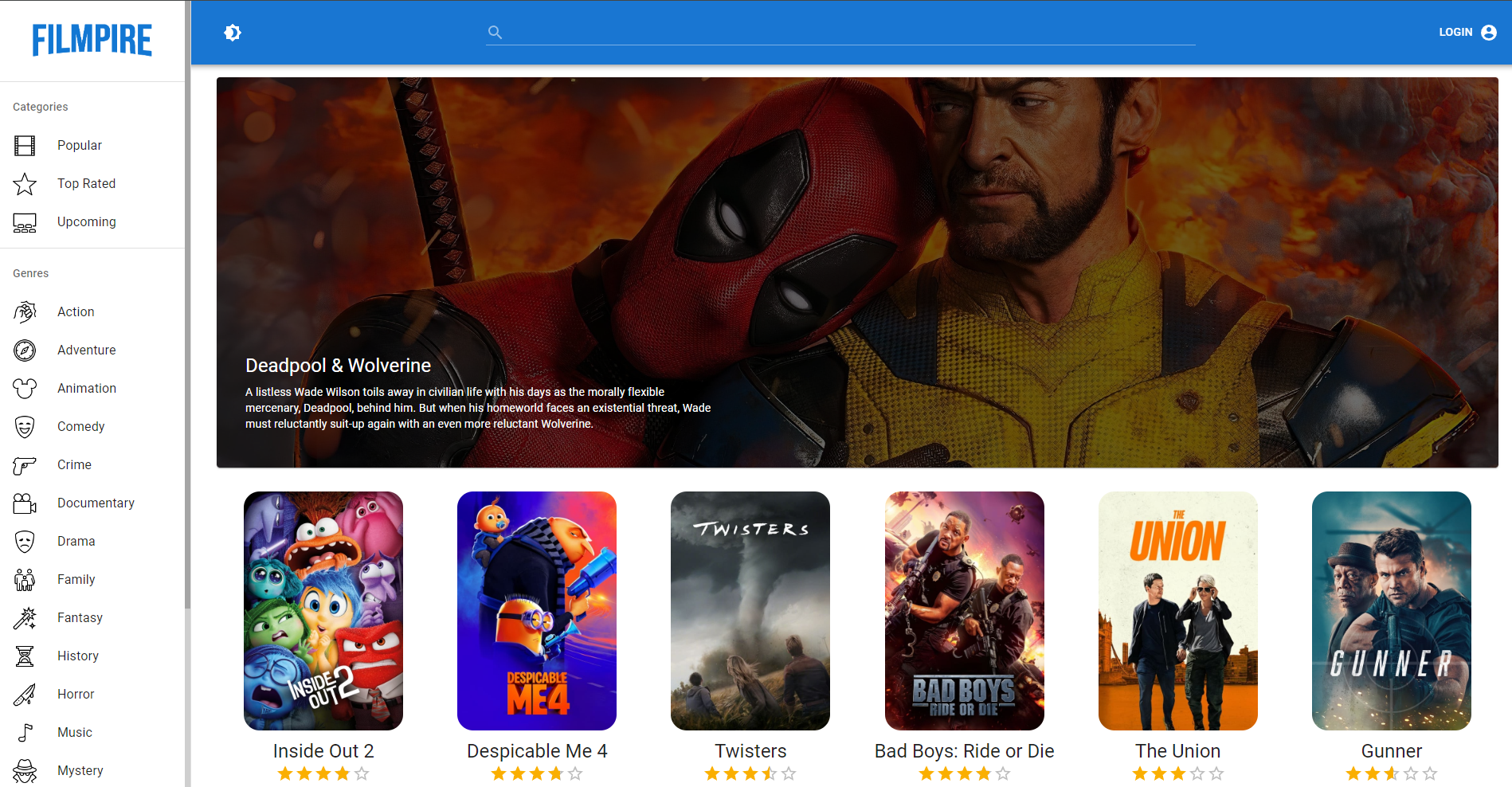
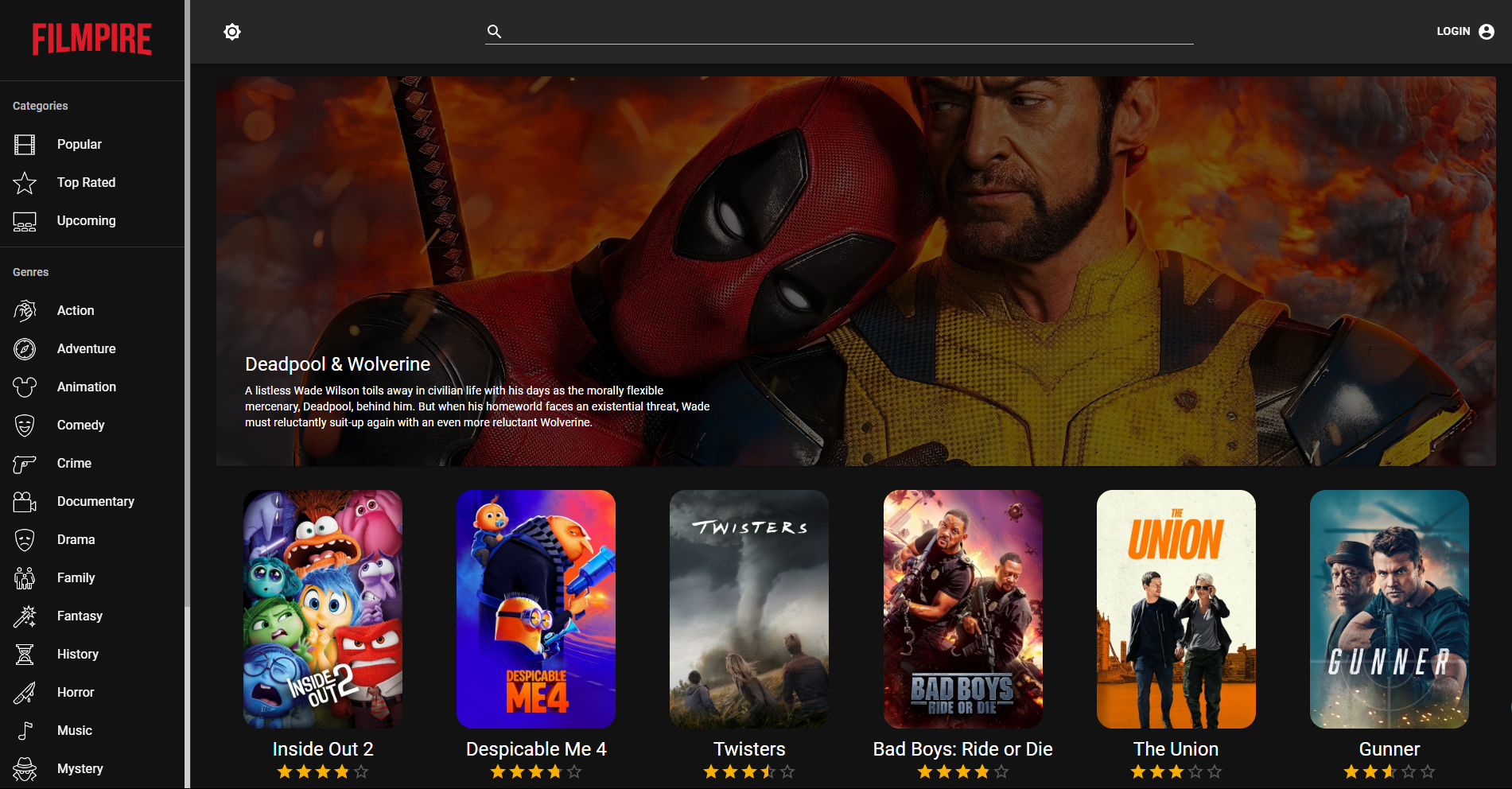
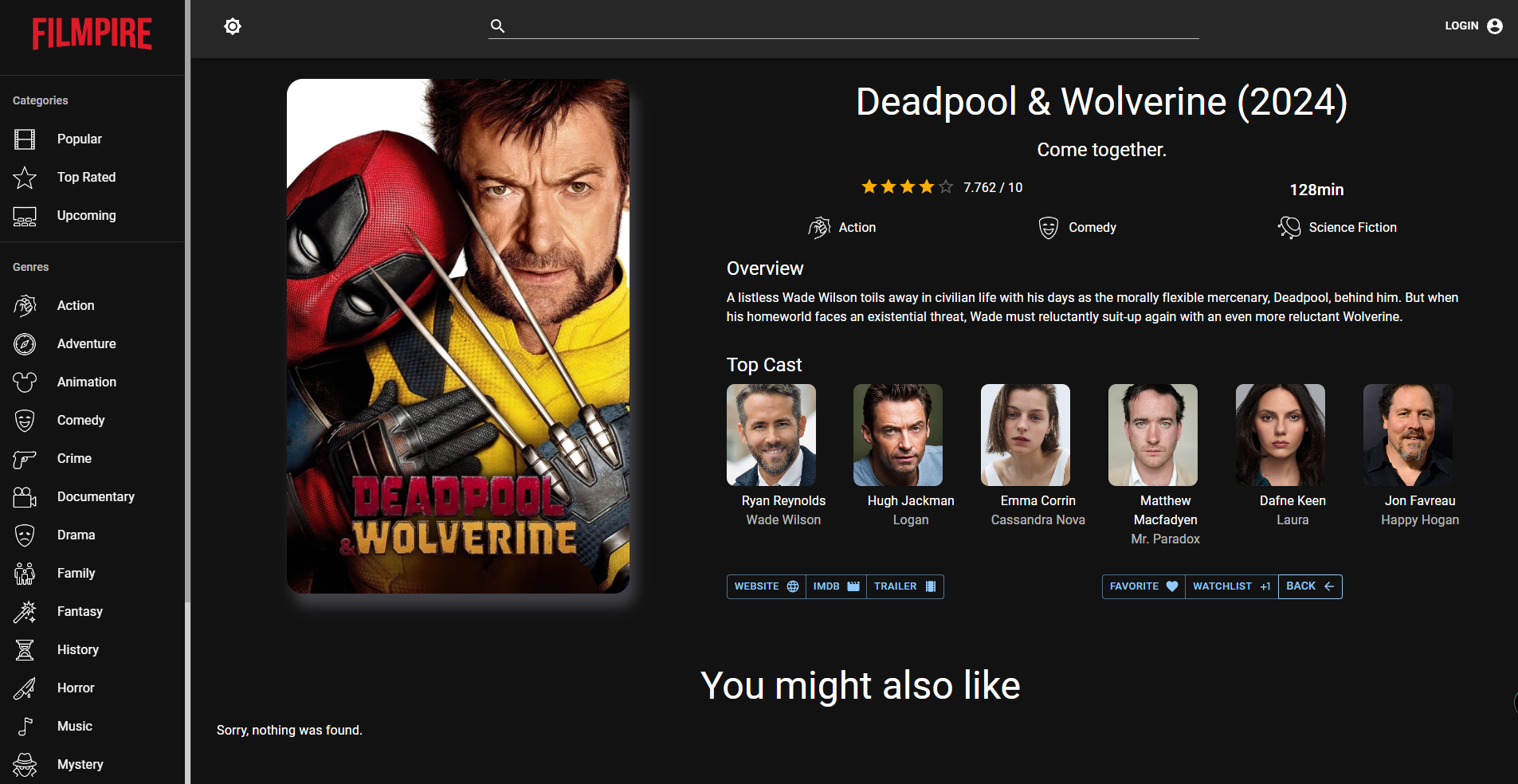
Searching Algorithm's Visualizer

 ❮
❮
❮
❮
Summary
Path Finder Algorithm Visualizer is a web-based application that allows users to visualize pathfinding algorithms in real-time. Users can set start and end points, place obstacles, and watch the algorithm find the shortest path between the two points on a grid.
Features
- Grid Board Interactive Grid: Users can click to set start and end points.
- Pathfinding Algorithms: Implement and visualize various pathfinding algorithms such as Dijkstra’s Algorithm, Depth-First Search (DFS).
- Animation Speed Control: Allow users to control the speed of the visualization.
Technologies Used
- Frontend: React, HTML, CSS, JavaScript.
- Algorithm Implementations: JavaScript (for implementing the pathfinding algorithms)
Learning Outcomes
- Algorithm Implementation: Gain a deep understanding of various pathfinding algorithms and how to implement them.
- Interactive UI Design: Enhance skills in creating interactive and responsive user interfaces.
- State Management: Improve proficiency in managing complex application state using Hooks.
- Real-Time Visualization: Learn techniques for visualizing algorithm processes in real-time.
Portfolio

 ❮
❮
❮
❮
Summary
The Portfolio Website is a personal web-based application designed to showcase your personal and professional information, projects, and skills. It provides a platform to display project details with screenshots and interactive features to engage visitors.
Features
- Personal Information: A section to display your personal details, including your bio, skills, and contact information.
- Projects Showcase: Sections to highlight your personal and professional projects with descriptions and screenshots.
- Interactive Elements: Utilizes Framer Motion for interactive animations and transitions, enhancing the user experience.
- Contact Form: Integrated contact form using Nodemailer for sending emails directly from the website.
- Modern Design: A sleek and responsive design using React, HTML, and CSS to ensure a seamless user experience across devices.
Technologies Used
- React for building the frontend web application.
- HTML & CSS: for structuring and styling the web pages.
- Framer Motion for adding interactive animations and transitions.
- Nodemailer for implementing email sending functionality from the contact form.
Learning Outcomes
- Frontend Development: Enhance skills in building responsive and interactive web applications using React, HTML, and CSS.
- Animations: Gain experience in using Framer Motion for creating interactive animations and transitions.
- Backend Integration: Learn to integrate Nodemailer for handling email functionality in web applications.
- Portfolio Creation: Understand best practices for creating a personal portfolio to effectively showcase projects and skills.
Screenshots
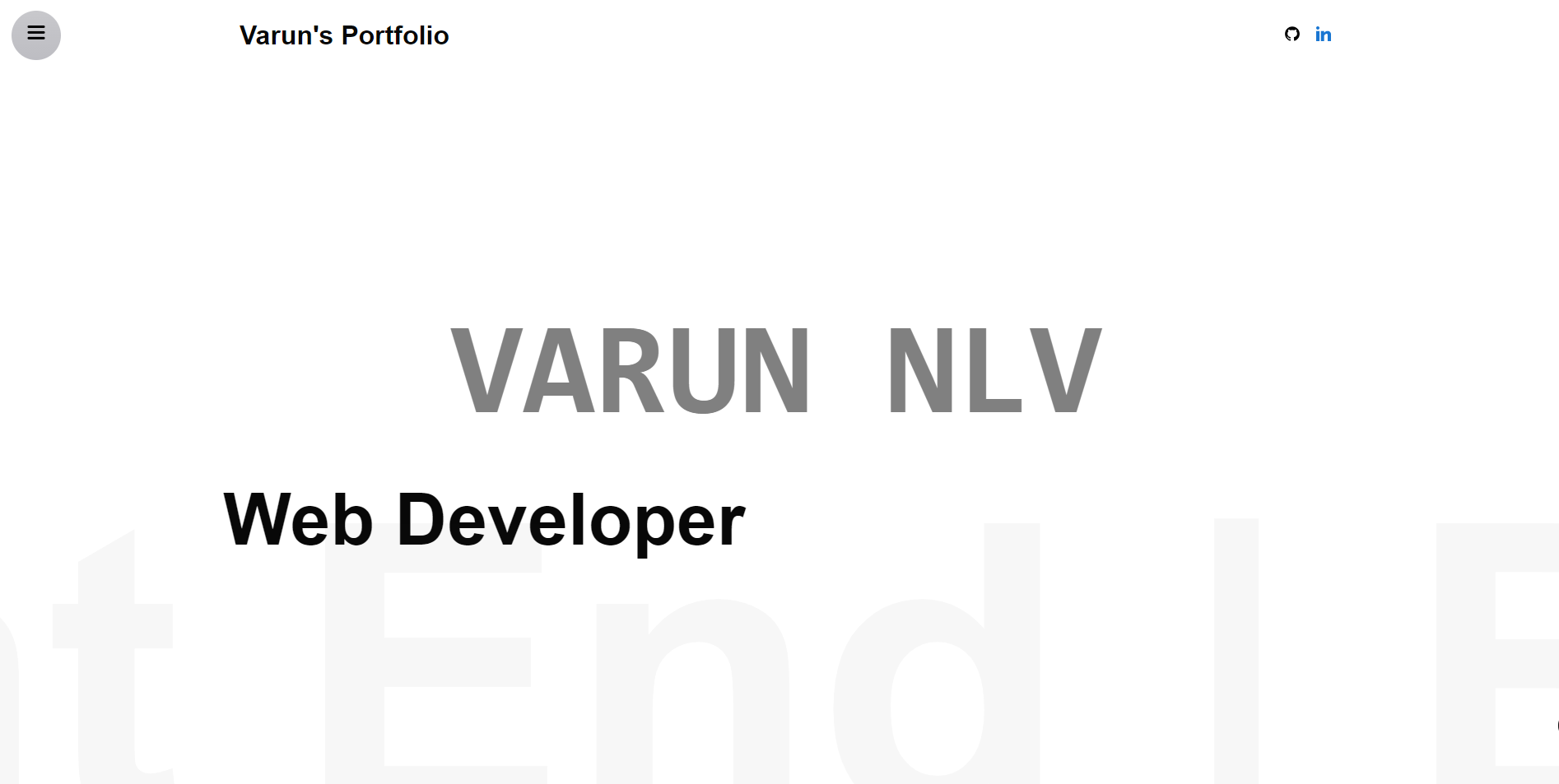
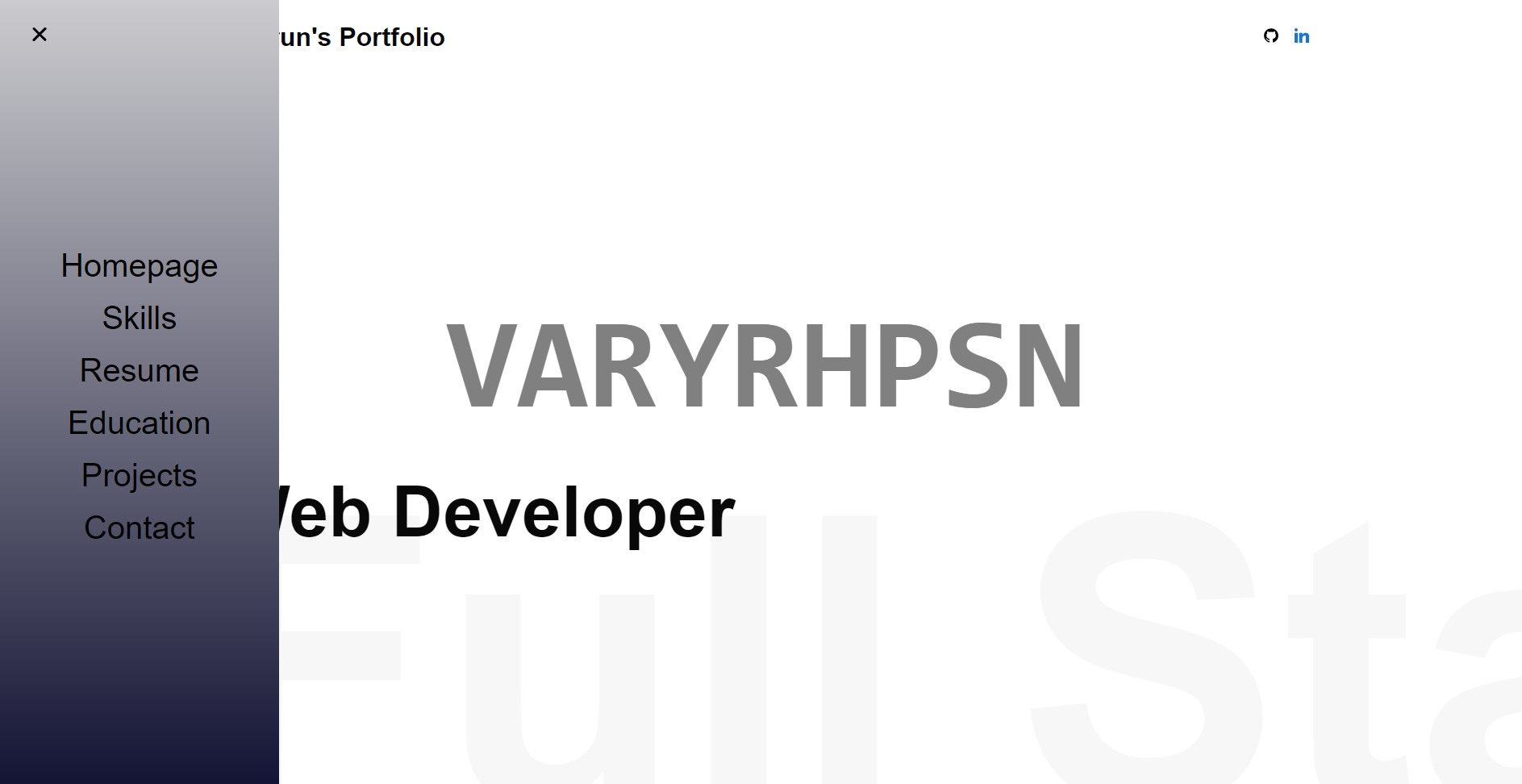
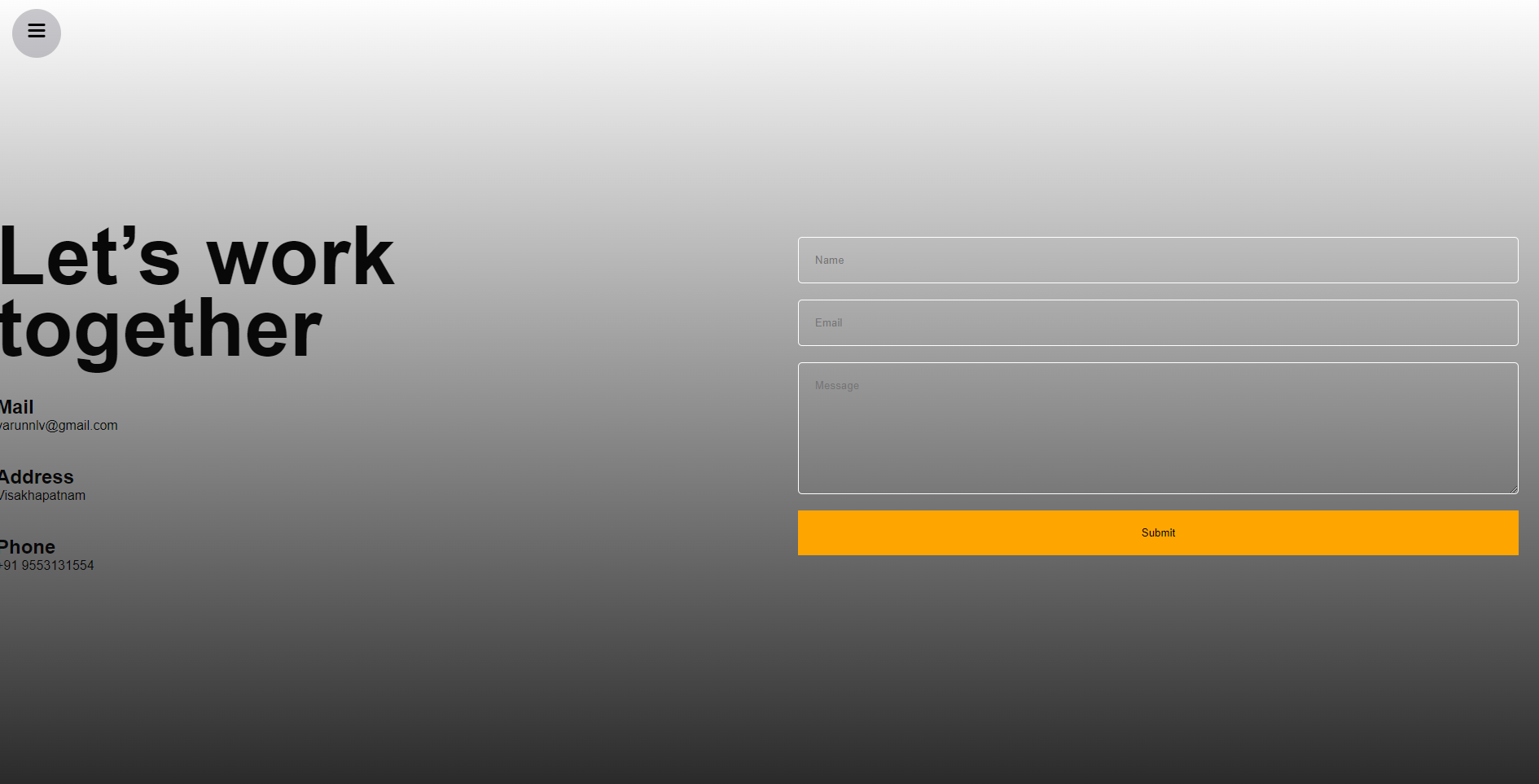
Expense Tracker

 ❮
❮
❮
❮
Summary
Expense Tracker is a web-based application designed to help users manage and track their expenses efficiently. Built with a modern and user-friendly interface, this system allows users to log in, input their expenses, and retrieve their data at any time.
Features
- User Management: Secure login system to store and retrieve user profiles and their associated expenses.
- Expense Management: Intuitive forms for users to input expense details, including date, category, amount, and description.
- Expense Retrieval: Users can view and retrieve their past expenses after logging in.
- Data Storage: Uses JSON Server to store user data and expenses, ensuring easy data management and retrieval.
Technologies Used
- React For building the frontend web application.
- HTML & CSS for structuring and styling the web pages.
- React Router for handling client-side routing and navigation within the web application.
- JSON Server for storing and retrieving user data and expenses.
Learning Outcomes
- Frontend Development: Gain experience in building responsive and interactive web applications using React, HTML, and CSS.
- Routing: Learn to use the latest version of React Router for client-side routing and navigation.
- Backend Simulation: Understand how to use JSON Server to simulate a backend for storing and retrieving data.
- Data Security: Implement basic user authentication and secure data management practices.
Screenshots
VFLEX


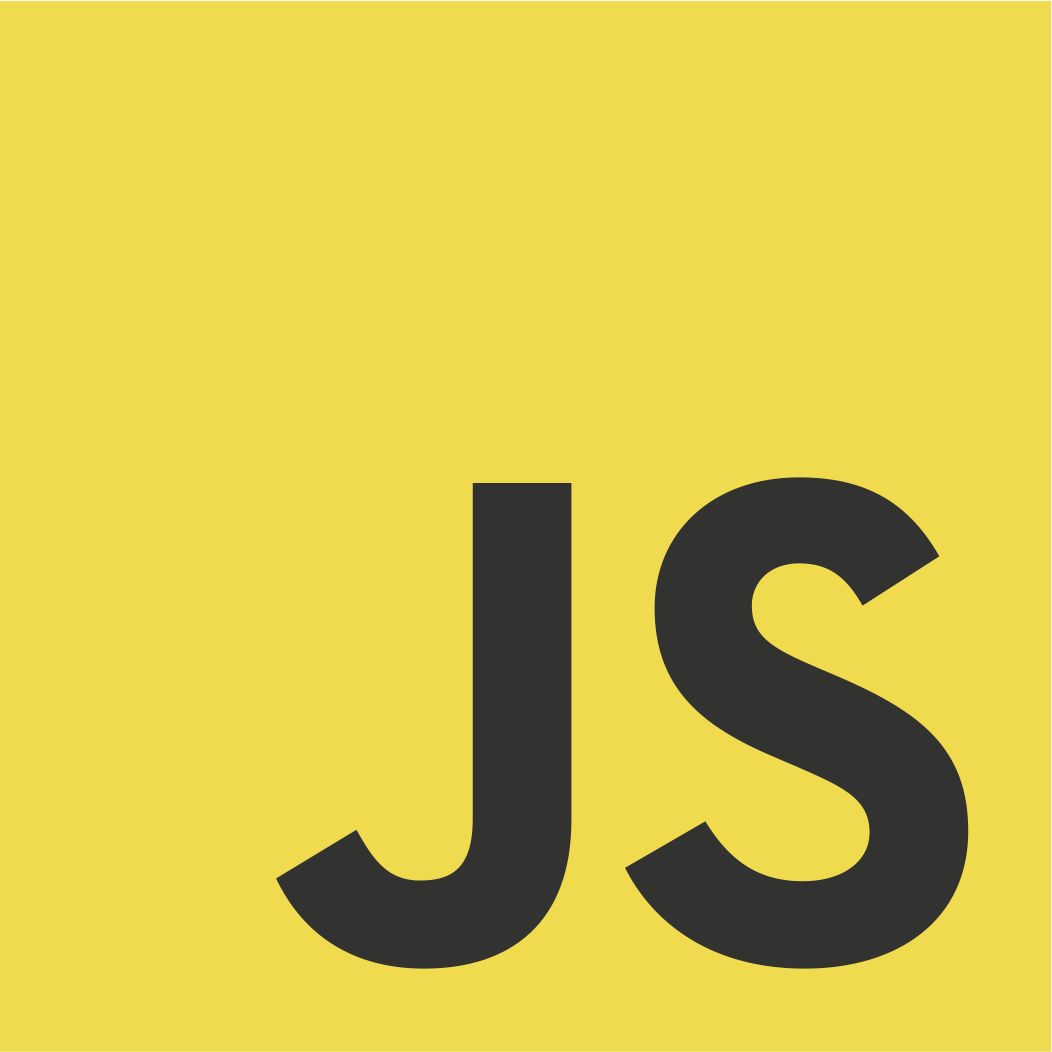 ❮
❮
❮
❮
Summary
VFLEX is a Static UI website designed to practice and demonstrate the Flexbox layout concept. It allows users to dynamically add cards with their own descriptions and headings, which are arranged using Flexbox. The site is responsive, with each card featuring a randomly assigned color.
Features
-
Dynamic Card Addition: Users can add cards with custom descriptions and headings.
- Flexbox Layout: Cards are arranged using the Flexbox layout, demonstrating various Flexbox properties and behaviors.
- Responsive Design: The layout adapts to different screen sizes, ensuring a seamless user experience on all devices.
- Random Colors: Each card is assigned a random color to enhance visual variety and appeal.
Technologies Used
- HTML & CSS for structuring and styling the web pages.
- JavaScript for adding dynamic functionality, such as generating random colors and handling user input.
Learning Outcomes
-
Flexbox Layout: Effectively using Flexbox properties to create a flexible and responsive layout. Gain practical experience in using Flexbox to create flexible, responsive layouts.
- Dynamic Web Development: Enhance skills in JavaScript for handling dynamic content and user interactions.
- Responsive Design Principles: Learn and apply best practices for responsive web design.
- Visual Design: Understand the impact of color in UI design and how to implement random color generation in a cohesive manner.
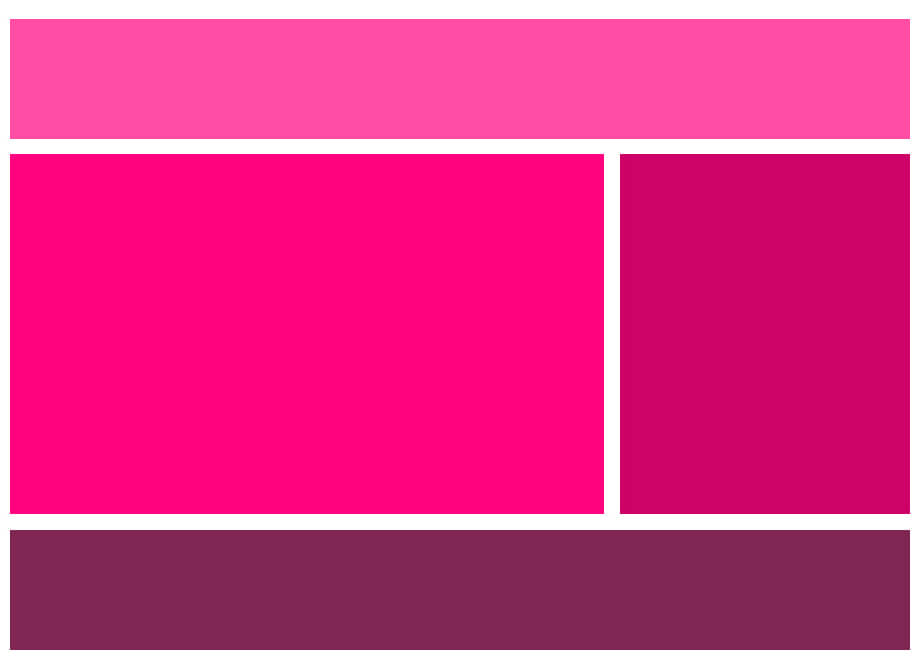

Screenshots
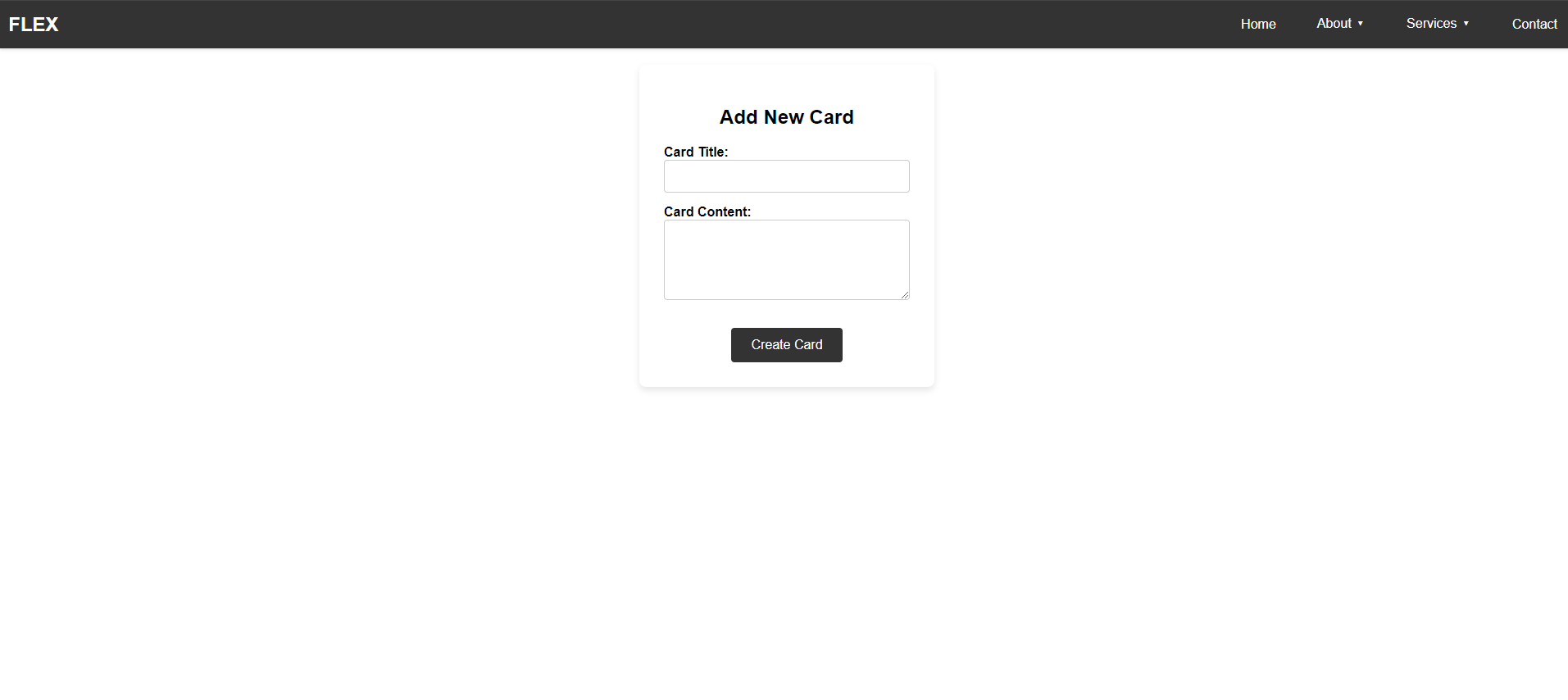
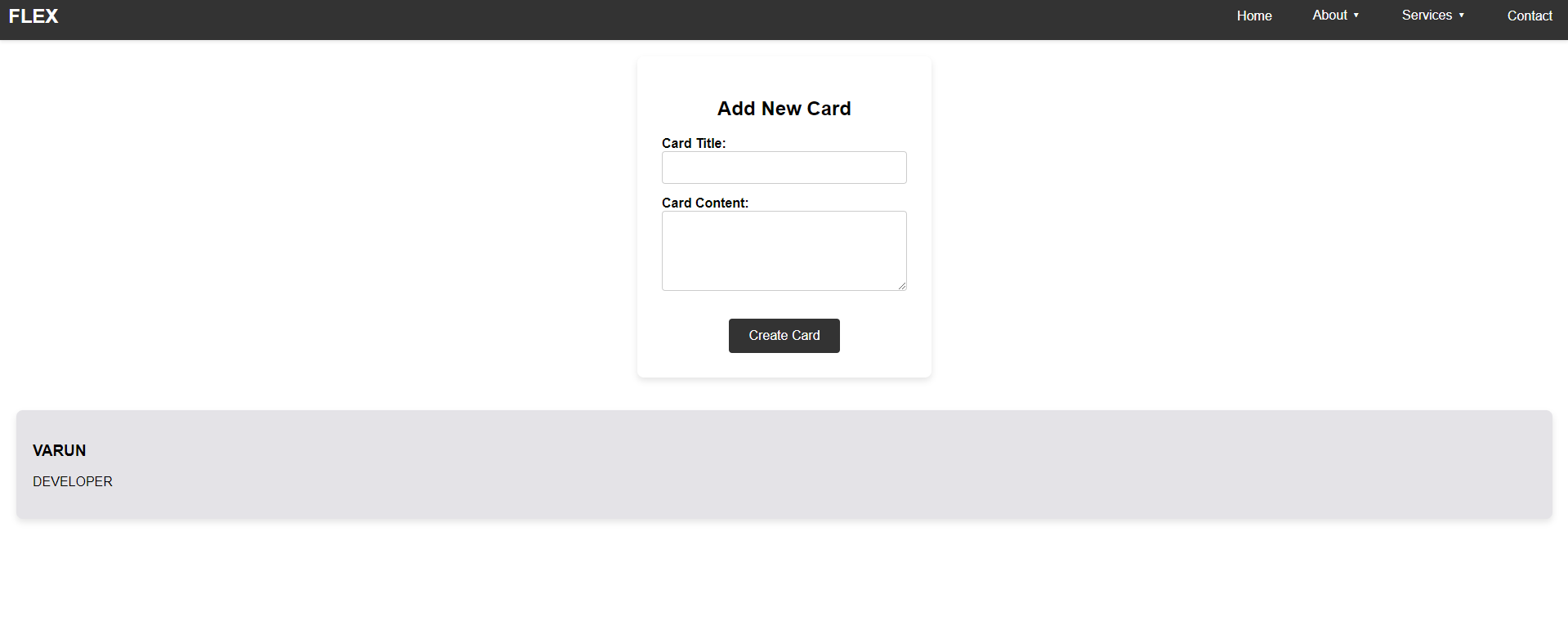
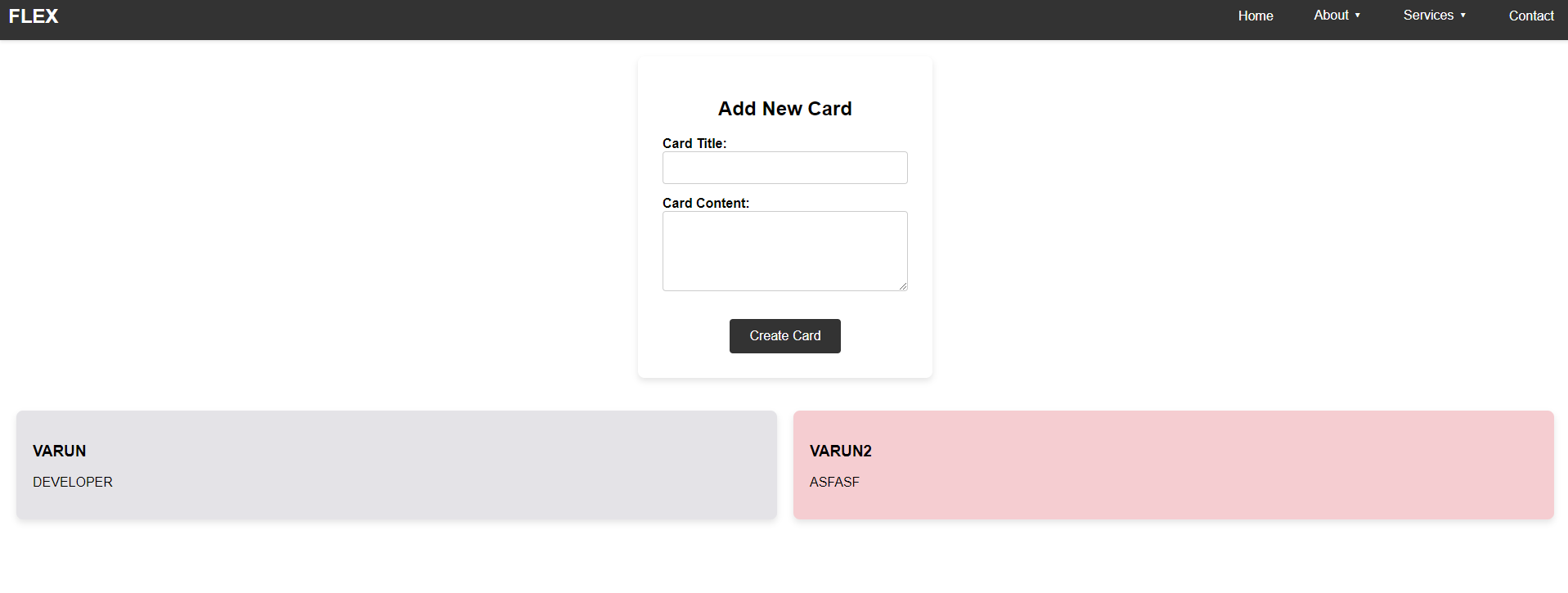
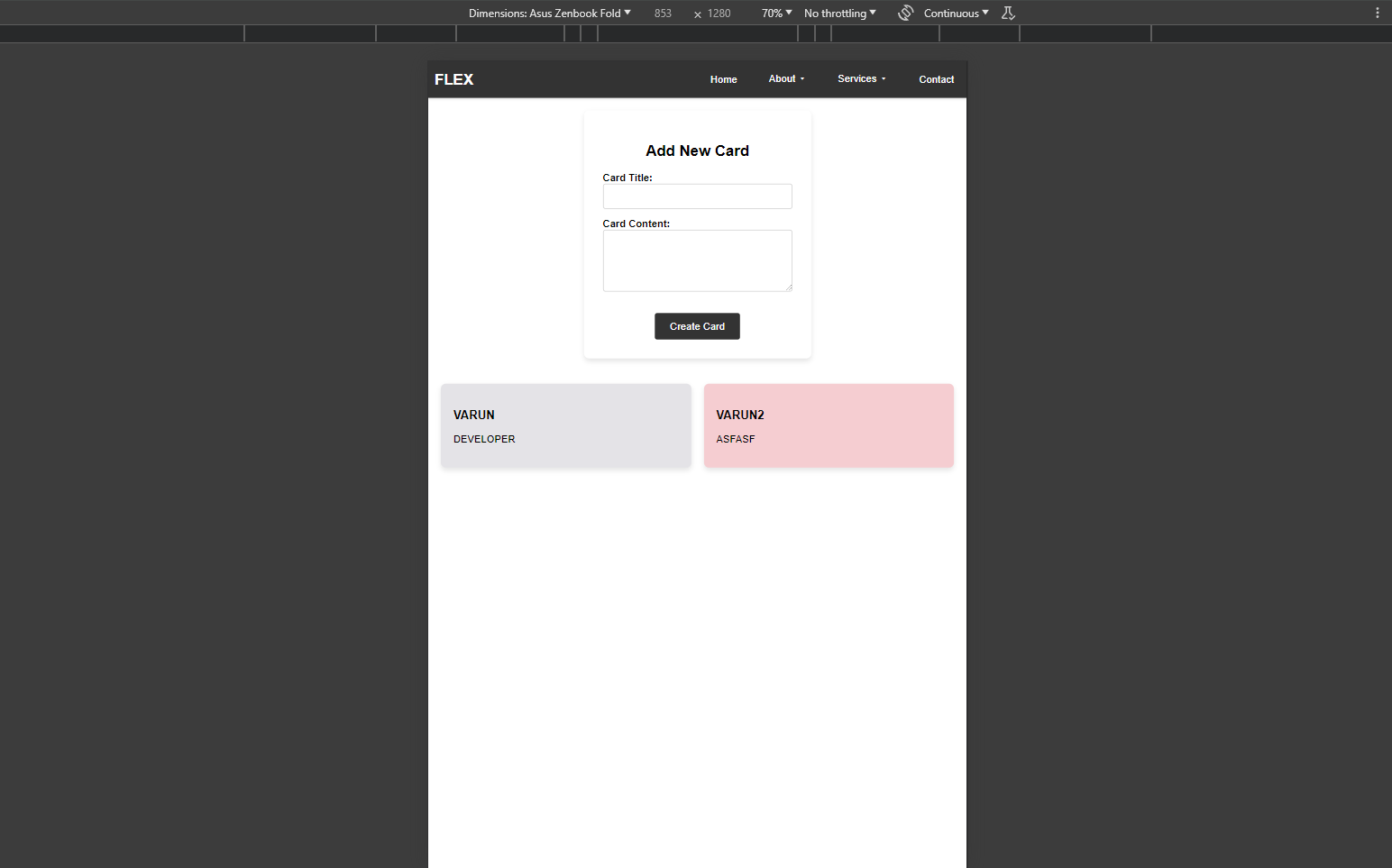
VGRID


 ❮
❮
❮
❮
Summary
VGRID is a Static UI website designed to practice and master the CSS Grid layout concept. It allows users to dynamically add content, which is arranged using CSS Grid. The site demonstrates the flexibility and power of CSS Grid in creating responsive and complex layouts.
Features
- Dynamic Card Addition: Users can add cards with custom descriptions and headings.
- CSS Grid Layout: Items are arranged using CSS Grid, showcasing various grid properties and layouts.
- Responsive Design: The layout adapts to different screen sizes, ensuring a seamless user experience on all devices.
- Random Colors: Each card is assigned a random color to enhance visual variety and appeal.
Technologies Used
- HTML & CSS for structuring and styling the web pages.
- JavaScript for adding dynamic functionality, such as generating random colors and handling user input.
Learning Outcomes
- CSS Grid Layout: Gain practical experience in using CSS Grid to create flexible, responsive layouts.
- Dynamic Web Development: Enhance skills in JavaScript for handling dynamic content and user interactions.
- Responsive Design Principles: Learn and apply best practices for responsive web design.
- Visual Design: Understand the impact of color in UI design and how to implement random color generation in a cohesive manner.


Screenshots
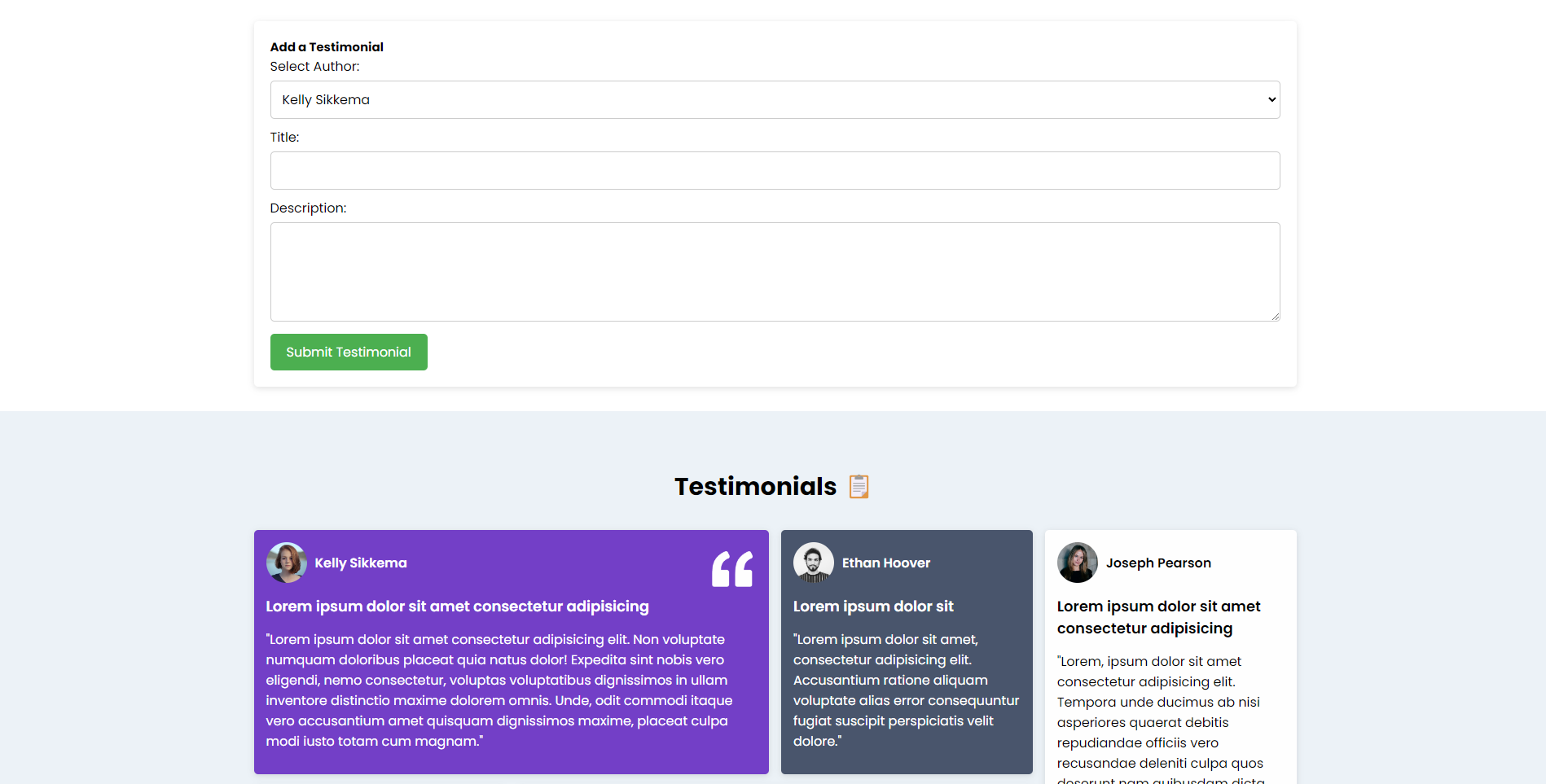
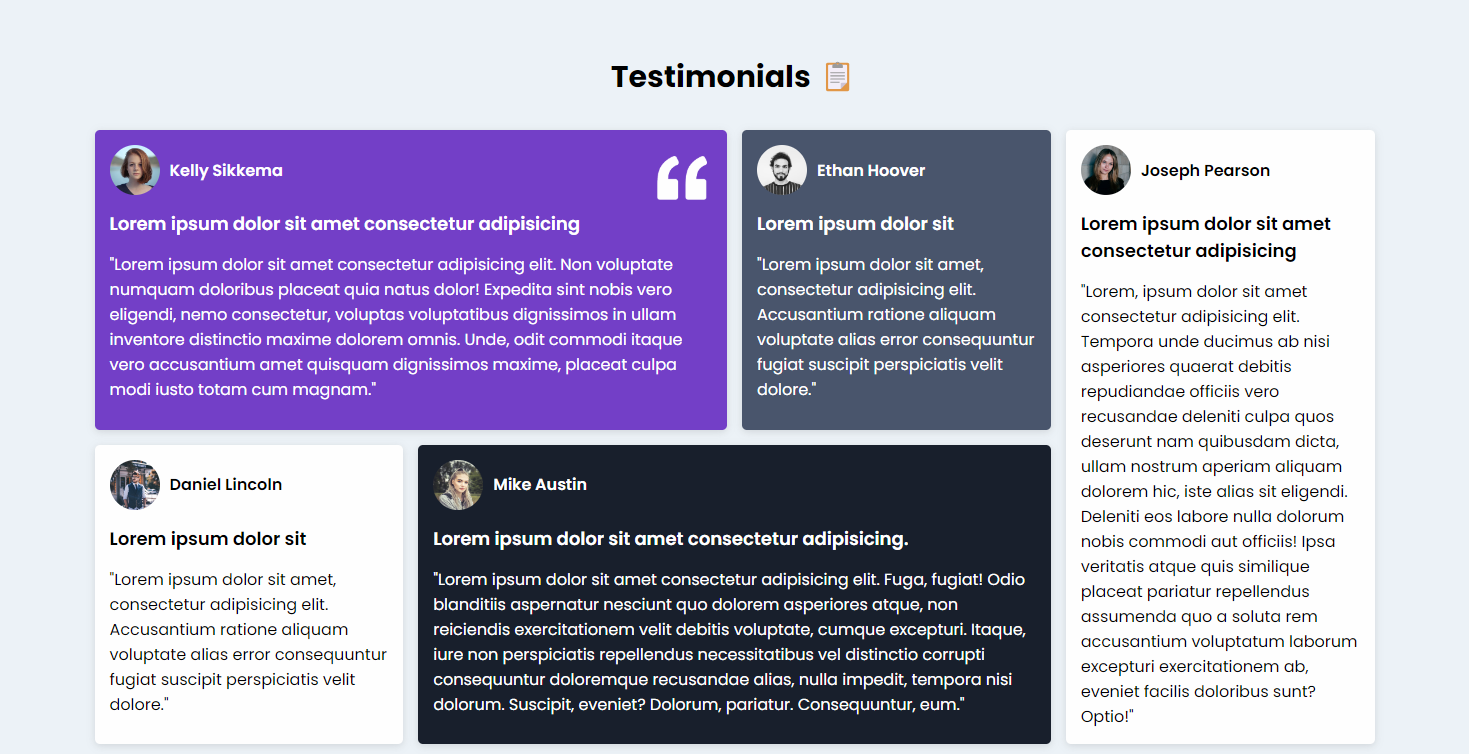
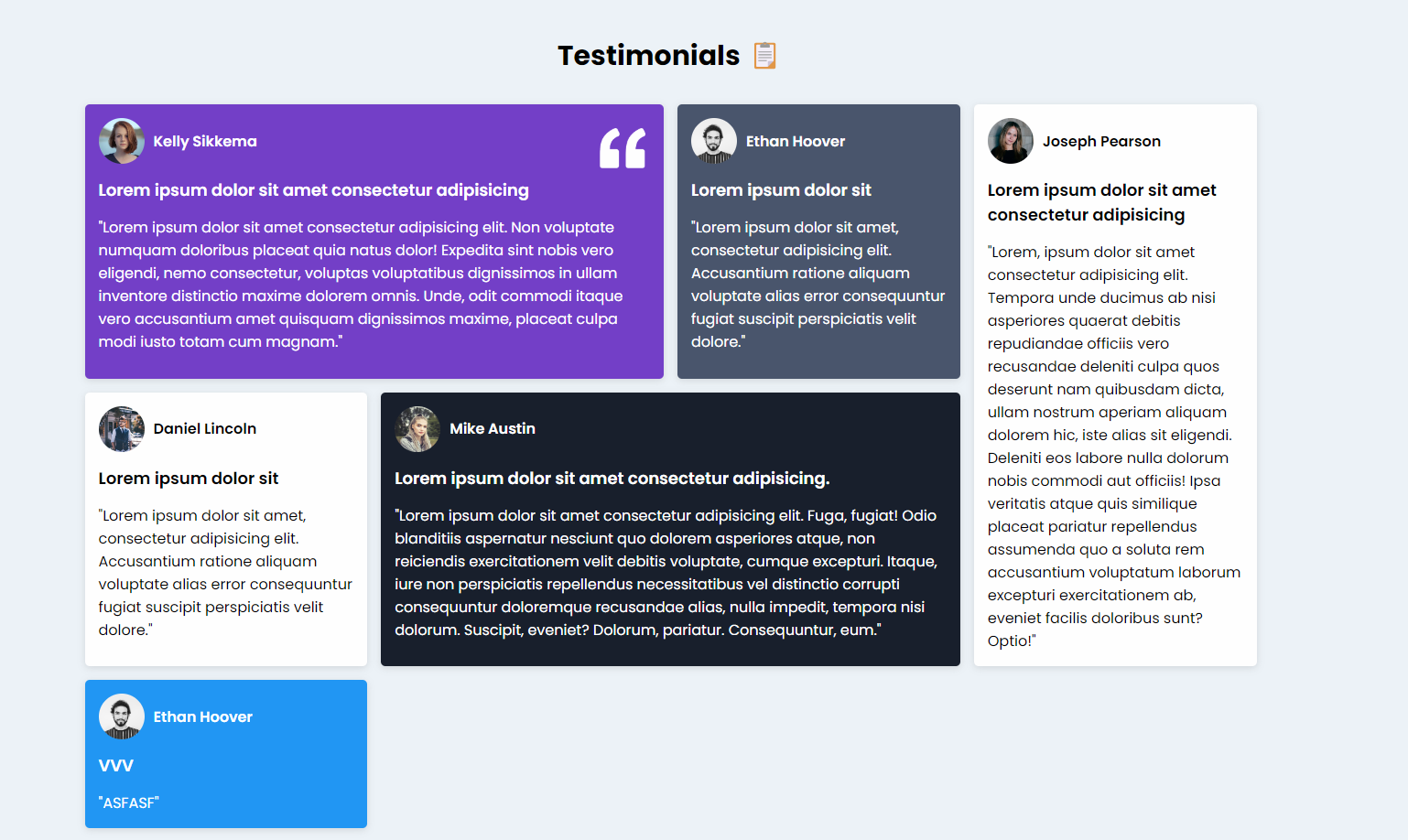
VKANBAN


 ❮
❮
❮
❮
Summary
VKANBAN is a static UI website designed to provide a visual task management system using the Kanban methodology. Similar to Jira, this application allows users to drag tasks between columns to track their status, making it easy to manage and visualize workflow.
Features
- Task Management: Users can create tasks with descriptions and assign them to columns representing different stages of a workflow (e.g., To Do, In Progress, Done).
- Drag and Drop: Tasks can be dragged and dropped between columns to update their status.
- Dynamic UI: The interface updates in real-time to reflect the current status of tasks.
Technologies Used
- HTML & CSS for structuring and styling the web pages.
- JavaScript for adding dynamic functionality, such as generating random colors and handling user input.
Learning Outcomes
- Drag and Drop API: Gain practical experience in using JavaScript to implement drag-and-drop functionality.
- Dynamic Web Development: Enhance skills in JavaScript for handling dynamic content and user interactions.
- Task Management Concepts: Understand the principles of task management and the Kanban methodology.
- Responsive Design Principles: Learn and apply best practices for responsive web design.
Screenshots
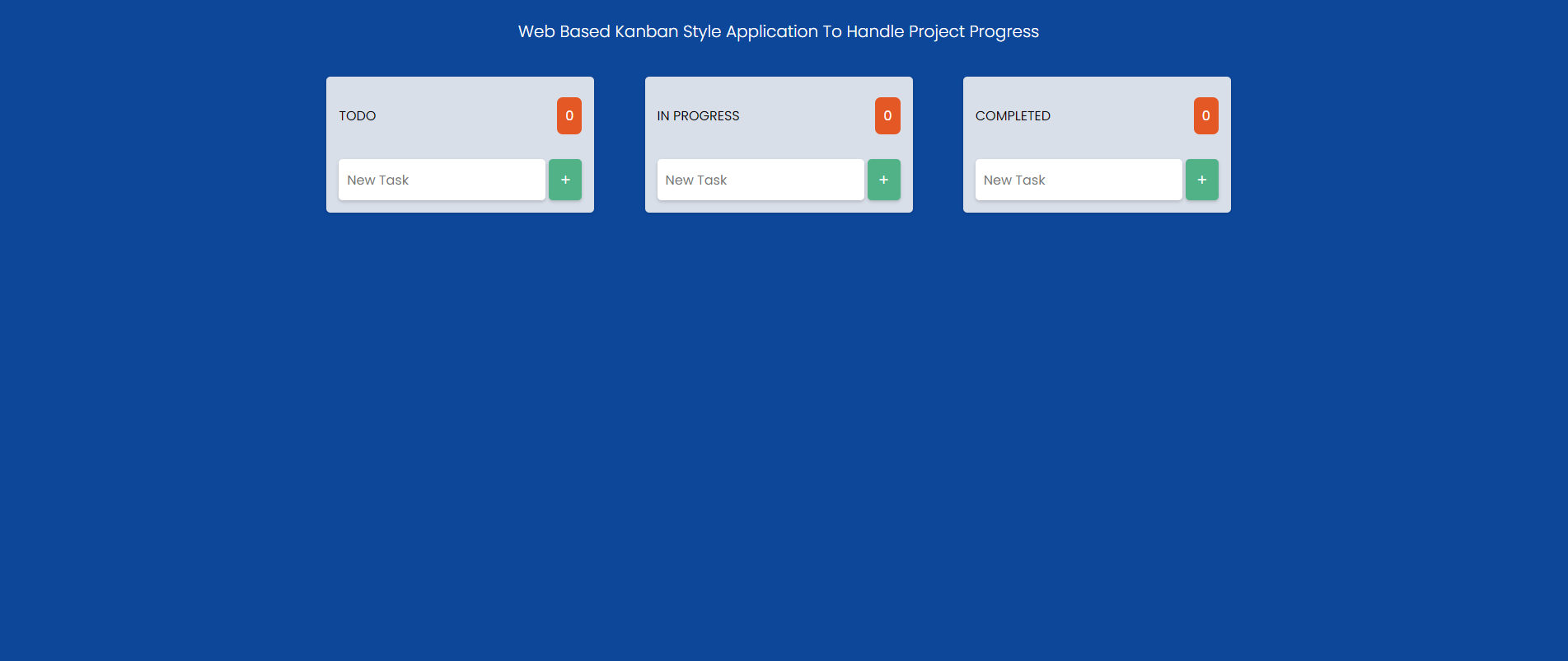
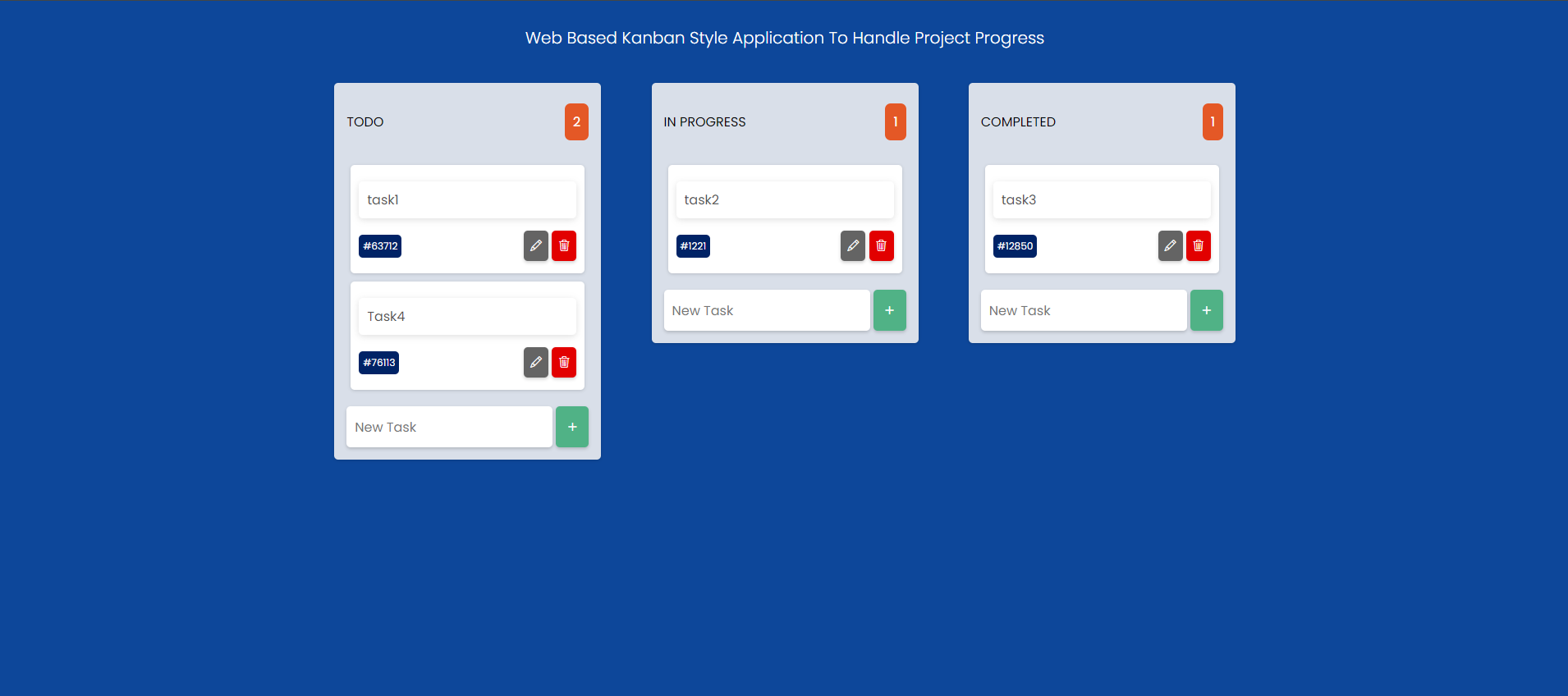
VPORTFOLIO


 ❮
❮
❮
❮
Summary
The Portfolio Project is a comprehensive web-based application designed to showcase detailed information about your various projects. This includes summaries, features, technologies used, and learning outcomes for each project. The portfolio serves as an in-depth professional presentation of your work and skills.
Features
- Project Summaries: Each project includes a brief overview summarizing its purpose and goals.
- Detailed Descriptions: In-depth explanations of the features, technologies used, challenges faced, and solutions implemented for each project.
- Learning Outcomes: Clear documentation of the skills and knowledge gained from each project.
- Interactive UI: A user-friendly and visually appealing interface to navigate through different projects.
Technologies Used
- HTML & CSS for structuring and styling the web pages.
- JavaScript for adding dynamic functionality, such as generating random colors and handling user input.
- React for building the frontend web application.
Learning Outcomes
- Comprehensive Documentation: Develop skills in documenting and presenting detailed information about projects.
- UI/UX Design: Enhance abilities in creating an engaging and intuitive user interface.
- Project Presentation: Learn to effectively showcase projects, highlighting key aspects and learning outcomes.
- Interactive Content: Implement interactive elements to make the portfolio more engaging and user-friendly.
Screenshots
